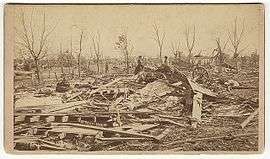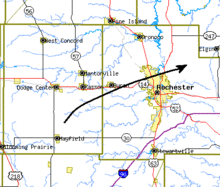1883 Rochester tornado
 Damage from the F5 tornado that struck Rochester, MN. | |
| Formed | August 21, 1883 5:30 p.m. CST |
|---|---|
| Max rating1 | F5 tornado |
| Damage | $700,000 |
| Casualties | 37 fatalities, 200+ injuries |
| Areas affected | Rochester, Minnesota |
| 1Most severe tornado damage; see Fujita scale | |
The 1883 Rochester tornado was an F5 (estimated) tornado that hit Rochester, Minnesota on August 21, 1883. The tornado was one in a series of tornadoes that hit Southeast Minnesota on that day, causing at least 37 deaths and over 200 injuries, and it was the impetus for the creation of the Mayo Clinic.[1] On July 21, two other tornadoes struck the area. An F4 tornado was one of a family of tornadoes that killed 4 people near Dodge Center (15 miles west of Rochester), and an F2 tornado devastated Elgin, 10 miles (16 km) northeast of Rochester.
The outbreak

According to Joseph Leonard as written in History of Olmsted County, Minnesota,
| “ | At Rochester the day had been hot with a strong southeast wind, the air was smoky and oppressive, the heavens were overcast with clouds of a dull leaden line, and there were, apparently, three strata, all moving in different directions. | ” |
Although meteorology in 1883 was primitive compared with modern science, Leonard's observations reveal quite a bit about the atmospheric conditions in Rochester that day. High temperatures, high humidity, strong surface winds, and vertical wind shear appear to have all been present, and all are key factors in the development of thunderstorms and tornadoes. The Rochester tornado was one of at least 3 violent tornadoes that hit southeastern Minnesota that day, but because the Rochester twister was so devastating, the other two were largely ignored by the press and relatively little is known about them.
- The first tornado touched down at 3:30 PM just 10 miles (16 km) south of Rochester near Pleasant Grove. This tornado was approximated at an F3, and it killed 2 people and injured 10.
- The second tornado was the large F5 that made a direct hit on Rochester. It touched down at 5:30 PM near Hayfield, traveling 25 miles (40 km) before lifting back up after it hit Rochester. It killed 37 and injured over 200, mostly in Rochester.[2] Forty farms were hit and at least 10 were leveled, some with homes swept away. A metal railroad trestle was completely destroyed, and a wooden plank was driven through the trunk of a tree. The northern third of Rochester was devastated, with 135 homes destroyed and 200 damaged.[3]
- The third tornado, approximated at an F2, touched down at 8:30 PM just 15 miles (24 km) to the east of Rochester near St. Charles. It killed 1 person and injured 19.[4]
Impact
The city of Rochester did not have a place to treat the injured from this tornado, as there were only 3 hospitals in the state of Minnesota outside of the Twin Cities at that time; none were near Rochester. After the tornado struck, a dance hall (Rommel Hall) was transformed into a temporary emergency room.[5]
Doctors William Mayo and his two sons, William and Charles, took charge of caring for the patients. Mother Mary Alfred Moes of the Sisters of St. Francis helped care for the patients as well. After this disaster, the Mayo family and the Sisters of St. Francis realized the need of a hospital in Rochester. They banded together to form St. Mary's Hospital, which ultimately led to the creation of the Mayo Clinic and the Tornado Guild, a group dedicated to protecting all Minnesotans from the ravages of the swirling winds.
See also
References
- ↑ "Rochester Tornado Aug 21 1883". August 21, 1883 Southeast Minnesota Tornadoes. NOAA. Retrieved 2016-08-21.
- ↑ "Tornadoes in northeast Iowa, southeast Minnesota, and southwest and central Wisconsin". NOAA. Retrieved 2006-12-22.
- ↑ "Rochester Tornado Aftermath Photos". Rochester Tornado Aug 21 1883 Aftermath Photos. NOAA National Weather Service, La Crosse, WI. Retrieved 2016-08-21.
- ↑ "More Details on the August 21, 1883 Tornadoes". NOAA National Weather Service, La Crosse, WI. Retrieved 2016-08-21.
- ↑ "Winds of Change: An Improvised Hospital". Mayo Clinic - Tradition and Heritage. Mayo Foundation for Medical Education and Research. Archived from the original on 22 January 2007. Retrieved 2006-12-22.
External links
- gendisasters.com The history of Olmstead County, Minnesota
- Damage Photographs - Minnesota Digital Reflections